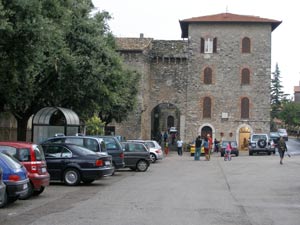Todi's country
Castle of San Terenziano
Along the Gualdo Cattaneo-Todi road, at an elevation of 500 meters, stands this castle built in the 14th century to defend the people. The locality has ancient origins (1st cent. AD): the Romans called it loco petroso (rocky place) for its quarries of travertine and limestone. The castle was indeed built from the local stone, in a traditional square plan. It took the name of Terenziano, the first bishop of Todi, whom the emperor Hadrian had decapitated together with Flacco, the high priest of the College of the augustali: the next night some Christian women gathered the corpses of the martyrs and brought them to the Petroso upland plain, which from that moment on was called San Terenziano. The castle followed the political and military events of Todi, which appointed commanders to govern it; a house inside it still bears the coat of arms of the Atti on the lintel. It belonged to the populace of Todi and was part of the Colle, Valle and Cammucia quarters. In 1354 it was attacked by the militias of friar Moriale d’Albarno, who, after having unsuccessfully attacked Spello and Beroide and having sacked the territories of Trevi and Montefalco, was heading toward Todi. Moriale, a Provencal condottiere and the captain of the “Grande Compagnie,” was convinced by his brothers to go to Rome, where Cola di Rienzo had recently returned. Accused unjustly by the tribune, he was arrested together with his brothers and decapitated on 29 October 1354. His death was desired especially by Innocent VI, who reformed the curia, eradicating abuses and violence through the court of the Inquisition. In 1440, after the castle of Castelvecchio was destroyed by Francesco I Sforza, the priors of Todi assigned the church bell to the community of San Terenziano. In the Renaissance the Cesi established their residence there, building the Palazzo Cesi, which is still visible today. Angelo Cesi commissioned the architect Valentino Martelli to build a number of edifices inTodi and in the Gualdo Cattaneo area. The Church of San Terenziano stands inside the castle, a parish church with a vast territory under the Chapter of Todi. It was governed by a few canons, an archpriest and a chamberlain. It is a rarexample of a construction formed of two churches, one on top of the other: thelower church, built in the 11th century, where the sarcophagus with the saint’sremains was kept, and the upper church, built in the late 1200s. In 1715 the saint’s tomb was opened, and his ashes, collected in a reliquary, were placed underneath the altar of the upper church, which was subsequently restored by the bishop of Todi.

Castello di S.Terenziano
Sulla strada Gualdo Cattaneo-Todi, a 500 metri slm, si trova questo castello eretto nel XIV sec. a difesa della popolazione. Le origini della località sono antichissime (I sec.d.C.): dai romani era chiamato loco petroso per le cave ricche di pietra calcarea e travertino. Il castello, infatti, fu costruito secondo uno schema tipologico tradizionale a pianta quadrata, utilizzando la pietra locale. Prese il nome da Terenziano, primo vescovo di Todi, fatto decapitare dall’imperatore Adriano insieme a Flacco, sommo sacerdote del Collegio degli Augustali: la notte seguente alcune donne cristiane raccolsero le spoglie dei martiri e le trasportarono sull’altipiano di Petroso che da quel momento si chiamò S. Terenziano. Il castello seguì sempre le vicende politiche e militari di Todi che v’insediò appositi castellani; un’abitazione all’interno delle mura porta ancora sull’architrave lo stemma degli Atti; appartenne al plebato di Todi ed era pertinenza dei rioni Colle, Valle e Cammucia. Nel 1354 fu attaccato dalle milizie di fra Moriale d’Albarno, il, quale dopo aver attaccato inutilmente Spello e Beroide e saccheggiato i territori di Trevi e Montefalco, si stava dirigendo alla volta di Todi. Il Moriale, condottiero provenzale e capitano della “Grande Compagnia”, dopo l’attacco a S.Terenziano fu convinto dai suoi fratelli a recarsi A Roma, dove era da poco tornato Cola di Rienzo; accusato ingiustamente dal tribuno, fu arrestato insieme ai suoi fratelli e decapitato il 29 ottobre1345.La sua morte fu voluta soprattutto da Innocenzo VI, il quale riformò la curia, estirpandone gli abusi e le violenze, attraverso il tribunale dell’Inquisizione. Nel 1440, dopo la distruzione del castello di Castelvecchio da parte di Francesco I Sforza, i priori di Todi assegnarono la campana della chiesa alla comunità di S. Terenziano. Nel Rinascimento vi stabilirono la residenza i Cesi che edificarono l’omonimo palazzo, ancora oggi visibile; Angelo Cesi, infatti, incaricò l’architetto Valentino Martelli di costruire alcuni palazzi a Todi e nei dintorni di Gualdo Cattaneo. All’interno del castello si trova la chiesa di S. Terenziano, pievania di un vasto territorio dipendente dal Capitolo tuderte; era retta da alcuni canonici, un arciprete e un camerario. E’ un raro esempio di costruzione formata da due chiese sovrapposte: l’inferiore del sec.XI, dove fu collocato il sarcofago con le spoglie del Santo, la superiore costruita alla fine del ‘200.Nel 1715, il sepolcro del Santo fu aperto, e le ceneri, raccolte in un reliquiario, trasportate sotto l’altare della chiesa superiore, successivamente restaurata dal vescovo di Todi. Il castello di S.Terenziano fece sempre parte del comune di Todi. Sulla porta d’ingresso, affiancata da una maestosa torre quadrata, fa spicco ancora lo stemma dell’aquila tuderte.